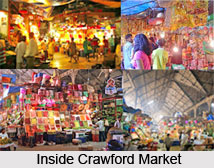 Crawford Market which is officially known as Mahatma Jyotiba Phule Mandai is an architectural landmark in colonial western mark, now a heritage market place in Mumbai, Maharashtra.
Crawford Market which is officially known as Mahatma Jyotiba Phule Mandai is an architectural landmark in colonial western mark, now a heritage market place in Mumbai, Maharashtra.
Location of Crawford Market
Crawford Market which is officially known as Mahatma Jyotiba Phule Mandai is situated opposite the Mumbai Police headquarters, just north of Chhatrapati Shivaji Terminus railway station and west of the J.J. flyover at a busy intersection.
History of Crawford Market
Crawford Market or Mahatma Jyotiba Phule Mandai is one of most famous markets in Southern part of Mumbai, Maharashtra. Crawford Market or Mahatma Jyotiba Phule Mandai is named after Arthur Crawford, the first Municipal Commissioner of the city of Mumbai. Crawford Market was later named after Mahatma Jotirao Phule after a long struggle by the President of Mahatma Phule Smarak Samiti, Mukundraoji Bhujbal Patil. Crawford Market or Mahatma Jyotiba Phule Mandai was completed in the year 1869, The land of Crawford Market or Mahatma Jyotiba Phule Mandai was donated to the city by Cowasji Jehangir. After Independence of India in the year 1947, Crawford Market or Mahatma Jyotiba Phule Mandai was renamed after Maharashtrian social reformer, Mahatma Jyotirao Phule. In the year 1882, Crawford Market or Mahatma Jyotiba Phule Mandai was the first in India to be lit up by electricity. Crawford Market was designed by British architect William Emerson. The edifice is a blend of Norman and Flemish architectural styles. The friezes on the outside entrance of Crawford Market depicting Indian farmers, and the stone fountains inside, were designed by Lockwood Kipling, father of novelist Rudyard Kipling.

Geography of Crawford Market
Crawford Market covers an area of 22,471 sq m of which 5,515 sq m (59,363 sq ft) is occupied by the building itself. Crawford Market was built using coarse buff coloured Kurla stone, with red-stone from Bassein . Crawford Market has a 15 m high skylight awning designed to allow the sunlight brighten up the marketplace.
Importance of Crawford Market
Crawford Market houses a wholesale fruit, vegetable and poultry market in Southern part of Mumbai. One end of the market is a pet store. Different varieties of dogs, cats, and birds can be found in this area. Also, endangered species are illegally sold there. Most of the sellers inside Crawford Market sell imported items such as foods, cosmetics, household and gift items. Crawford Market was the main wholesale market for fruits in Mumbai until March 1996, when the wholesale traders were relocated to Navi Mumbai in Mumbai.
Visiting Information
One can easily reach Crawford market area from CST railway station or take a private taxi from there. One can also take a bus to VT station or ride in car. There is car parking available but very costly and has to be paid on an hourly basis and still difficult to get.



















